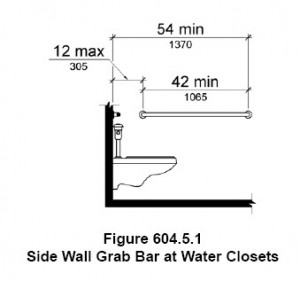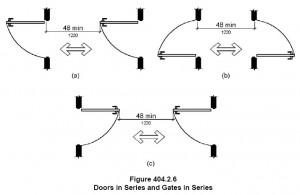What is ANSI?
ANSI is part of a model code. The IBC Model code has requirements for accessibility. It is found in Chapter 11 and references the
ANSI A117.1 Guidelines. ANSI on its own does not have any scoping requirements. In other words, it doesn’t tell you how many elements must be accessible. It mainly gives you technical guidelines on how to make elements accessible to people with disabilities.
ADA, on the other hand, is a civil rights law that is not tied to a building code.
Title III of the ADA requires that certain elements within facilities be accessible to the disabled community. Whether or not there is construction in a facility, the ADA still applies. Below you will find some other technical differences on the requirements between the ADA and ANSI guidelines.
Some Differences between ADA Design Guidelines and ANSI A117.1
In the 2010 ADA Standards, the side wall grab bars are required to be horizontal per the figure below
ANSI A117.1 , in addition to the horizontal grab bar, it requires a vertical grab bar at the side wall.
In the ADA, a set of doors in series has a certain dimension between the two doors.
But in ANSI A117.1 the same doors in series also require a turning space within the interim space.
Toilet paper dispensers at the water closet also have different requirements between ADA and ANSI. The 2010 ADA Standards requires that the dispenser be located between 7″-9″ from the face of the toilet
The ANSI Standards is more flexible on the position, and gives the designer more options
Inspector’s Corner
While doing an ANSI inspection at a multi-family housing project, I noticed the accessible parking space for one of the residential dwelling units. It was a covered parking space, but they forgot to also cover the access aisle. The post that is supporting the roof for the covered parking is in the way of the access aisle. A driver will have a hard time opening their door and maneuvering onto the access aisle with this parking space

Need CEUs
If you are interested in Building Code seminars check out my colleague Shahla Layendecker with
SSTL CodesIf you want to learn more about these standards, be sure to check out my books:









 Abadi
Abadi 
